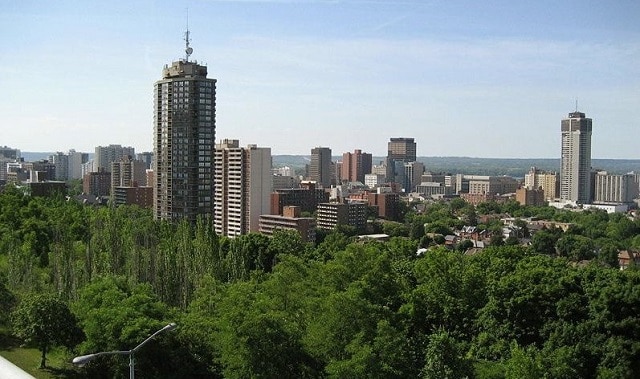Hamilton could ‘hollow out’ without family-friendly housing: report
Published June 25, 2021 at 3:41 am

Hamilton’s home-building policies need to be family-friendlier, especially since there is a climate crisis.
On Thursday, the Smart Prosperity Institute published a research paper that examines home-building and population trends in Hamilton from 2015 to ’20. The authors say Hamilton built less single-family housing in the second half of the 2010s than it did in the first.
This cost the city the chance to welcome new residents.
It has also, according to Oxford Economics, contributed to Hamilton having the third-most expensive housing market relative to income in North America. Only Toronto and Vancouver rank higher.
“I don’t think this will be too much of a surprise to anyone in Hamilton, but we’re seeing a lot of young families leave,” says Dr. Mike P. Moffatt, the senior director of Smart Prosperity. “Just in a three-year period, over 10,000 people moved to the surrounding area. It was mostly parents with their young children. And it’s not hard to see why. It’s simply a lack of housing options and higher prices in the Hamilton-Burlington region compared to prices from St. Catharines to Tillsonburg.”
Ontario’s population increase from 2015 to ’20 was 80 per cent higher than it was 2010-15. During the most recent five-year stretch, however, there was a 23-per-cent decrease in the number of single, semi-detached and row homes built in the Hamilton census metropolitan area. A 66-per-cent increase in new apartment units was also shy of that 80 per cent figure.
“Since 2017, the trends that we associate with Toronto are starting to happen in Hamilton,” adds Moffatt, who teaches at the Richard Ivey School of Business at Western University of London, Ont. “We had all of this big population growth across the region. We’ve changed our immigration targets, we’ve had a good Ontario economy and we’ve had an influx of non-permanent residents to attend colleges and universities — all of which I think is a fantastic thing.
“But cities like Hamilton and Burlington did not change their home-building pattern and, in fact, if anything, moved to build less housing.”
The knock-on effects of the housing crunch may be seen as two-fold. Having a significant portion of a city’s workforce live outside of it and use personal vehicles to go to work increases greenhouse-gas emissions.
It also creates a gap between the city’s tax revenue and cost of providing services.
“As somebody who would like to avoid sprawl, I don’t think it’s great for Ontario to have this exodus out of Hamilton, where people are often still working in Hamilton and then driving back to another city,” Moffatt says. “So, by finding a way to build more family-friendly, more climate-friendly housing that’s affordable, you’ll have better economic outcomes and environmental outcomes.”
Hamilton is well-rooted in the knowledge economy, thanks in large part to McMaster University and Mohawk College’s ability to attract post-secondary students. But if people don’t see a path to living and raising a family in the city, then they will look elsewhere for a home.
“You worry about the ability to attract and retain talent,” Moffatt says. “You have a lot of employers in Hamilton in aerospace and automotive and white-collar industries that are trying to attract talent. If people feel they’re in a situation where it’s, ‘I have to choose between raising a family or taking this job, then they are going to go work somewhere else.”
The city also has well-publicized infrastructure deficit. Over the decades, the population of the lower city has decreased as exurbs and suburbs have grown. Servicing that area could become more daunting yet, Moffatt says.
“At the municipal level, the thing I would get worried about is that Hamilton’s going to find itself in a situation where it has to provide a lot of services — transit, policing and so on — without the tax base,” he says. “So you’ve got these sort of out-of-towners using these services, but they’re not paying municipal property taxes.
“We’ve seen in the United States, the hollowing-out of urban centres and the costs that are involved … The municipal government needs to think about this and realize that if people are coming to Hamilton, but not living in Hamilton, then there’s going to be a disconnect between the cost of running the city and your tax base.”
Smart Prosperity’s work, which was funded with help from the West End Home Builders’ Association, does not address solutions or revisions to Hamilton’s home-building issues.
“You need a variety of forms that are family-friendly,” Moffatt says.
The 28-page paper is entitled: “Ontarians On The Move: Local Intelligence Report — Hamilton.” Moffatt’s fellow authors are Mohsina Atiq, Una Jefferson, Harshini Ramesh. Smart Prosperity is based at the University of Ottawa.
INsauga's Editorial Standards and Policies








